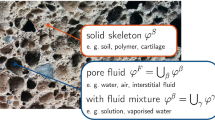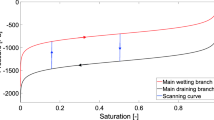Abstract
A method for modeling fluid–solid interactions in saturated porous media is proposed. The main challenge is the combination of the material and spatial descriptions. The deformation of the solid, which serves as a “container” to the fluid, is studied by following the motion of its material particles, i.e., in Lagrangian description. On the other hand, the motion of the fluid is described in spatial form, i.e., by using a Eulerian approach. However, the solid deforms and this implies a certain difference regarding the standard formulation used in spatial description of fluid mechanics where a fixed grid dissects space into elementary volumes. Here the grid is no longer fixed, and the elementary volumes will follow the deformation of the solid. Moreover, for the solid as well as for the fluid the balance equations are formulated in the current configuration, where interaction forces and couples are taken into account. By using Zhilin’s approach, entropy and temperature are incorporated in the system of equations. Constitutive equations are constructed for both elastic and inelastic components of force and couple stress tensors and interaction force and couple. The constitutive equations for elastic components are found on the basis of the energy balance equation; the constitutive equations for the inelastic components are proposed in accordance with the second law of thermodynamics. Particular emphasis is placed on the constitutive equations of the interaction force and couple, which result in a symmetric form only because of the “hybrid” approach combining the Lagrangian with the Eulerian description. Three possible examples of application of the theory have been presented. For each example, all required assumptions were first stated and discussed and then the complete set of the corresponding equations was presented.
Similar content being viewed by others
References
Biot M.A.: General theory of three-dimensional consolidation. J. Appl. Phys. 12, 155–164 (1941)
de Boer R.: Trends in Continuum Mechanics of Porous Media. Springer, Netherlands (2005)
de Boer R., Ehlers W.: On the problem of fluid- and gas-filled elasto-plastic solids. Int. J. Solids Struct. 22(11), 1231–1242 (1986)
Loret B., Simoes F.M.F.: A framework for deformation, generalized diffusion, mass transfer and growth in multi-specied multi-phase biological tissues. Eur. J. Mech. A Solid 24, 757–781 (2005)
Wei C.H., Muraleetharan K.K.: A continuum theory of porous media saturated by multiply immiscible fluids: II. Lagrangian description description and variational structure. Int. J. Eng. Sci. 40, 1835–1854 (2002)
Bowen R.M.: Compressive porous media models by use of the theory of mixtures. Int. J. Eng. Sci. 20(6), 697–735 (1982)
Bowen R.M.: Incompressive porous media models by use of the theory of mixtures. Int. J. Eng. Sci. 18, 1129–1148 (1980)
Wilmanski K.: Continuum Thermodynamics. Part 1: Foundations. World Scientific, Singapore (2008)
Anferov S.D., Scul’skiy O.I.: Modeling of fluid filtration through plastically deformed porous medium in the process of extrusion (in Russian). PNRPU Mech. Bull. 2, 29–47 (2014)
Hassanizaden M., Gray W.G.: General conservation equations for multi-phase systems: 3. Constitutive theory for porous media flow. Adv. Water Resour. 3, 25–40 (1980)
Nigmatullin B.E.: Foundations of Heterogenious Continuum Mechanics (in Russian). Nauka, Moscow (1978)
Borja R.I.: On mechanical energy and effective stress in saturated and unsaturated porous continua. Int. J. Solids Struct. 43, 1764–1786 (2006)
Chapelle D., Moireau P.: General coupling of porous flows and hyperelastic formulations—from thermodynamics principles to energy balance and compatible time schemes. Eur. J. Mech. B Fluid. 46, 82–96 (2014)
Li C., Borja R.I., Regueiro R.A.: Dynamics of porous media at finite strain. Comput. Methods Appl. Mech. 193, 3837–3870 (2004)
Vuong A.-T., Yoshihara L., Wall W.A.: A general approach for modeling interacting flow through porous media under finite deformation. Comput. Methods Appl. Mech. 283, 1240–1259 (2015)
Arienti M., Hung P., Morano E., Shepherd J.E.: A level set approach to Eulerian–Lagrangian coupling. J. Comput. Phys. 185, 213–251 (2003)
Donea J., Giuliani S., Halleux J.P.: An arbitrary Lagrangian–Eulerian finite element method for transient dynamic fluid-structure interaction. Comput. Method. Appl. Mech. 33, 689–723 (1982)
Hirt C.W., Amsden A.A., Cook J.L.: An arbitraty Lagrangian–Eulerian computing method for all flow speeds. J. Comput. Phys. 14, 227–253 (1974)
McGurn M.T., Ruggirello K.P., DesJardin P.E.: An Eulerian–Lagrangian moving immersed interface method for simulation burning solids. J. Comput. Phys. 241, 364–387 (2013)
Surana K.S., Blackwell B., Powell M., Reddy J.N.: Mathematical models for fluid–solid interaction and their numerical solutions. J. Fluid. Struct. 50, 184–216 (2014)
Brown, D.L., Popov, P., Efendiev, Y.: Effective equations for fluid-structure interaction with application to poroelacticity: applicable analysis. Int. J. Eng. Sci. 93, 4 (2014) doi:10.1080/00036811.2013.839780
Collins R.E.: Flow of Fluids Through Porous Materials. Reinolds Publishing Corporation, New York (1961)
Kunin I.A.: Kinematics of media with continuously changing topology. Int. J. Theor. Phys. 29(11), 1167–1176 (1990)
Gurtin M.E.: An Introduction to Continuum Mechanics. Academic Press, New York (1981)
Hauke J.: An Intriduction to Fluid Mechanics and Transport Phenomena. Springer, Netherlands (2008)
Zhilin P.A.: Rational Continuum Mechanics (in Russian). Polytechnic University Publishing House, St.Petersburg (2012)
Ivanova, E.A., Vilchevskaya, E.N., Müller, W.H.: Time derivatives in material and spatial description—What are the differences and why do they concern us?. In: Naumenko, K., Aßmus, M. (ed.) Advanced Methods of Continuum Mechanics for Materials and Structures, Springer, Berlin (2016)
Loicyanskii L.G.: Mechanics of Fluids (in Russian). Nauka, Moscow (1987)
Falkovich G.: Fluid Mechanics. A Short Course for Physicists. Cambridge University Press, New York (2011)
Ivanova E.A.: Derivation of theory of thermoviscoelasticity by means of two-component medium. Acta Mech. 215, 261–286 (2010)
Ivanova, E.A.: On one model of generalized continuum and its thermodynamical interpretation. In: Altenbach, H., Maugin, G.A., Erofeev, V. Mechanics of Generalized Continua., pp. 151–174. Springer, Berlin (2011)
Ivanova E.A.: Derivation of theory of thermoviscoelasticity by means of two-component Cosserat continuum. Tech. Mech. 32, 273–286 (2012)
Ivanova E.A.: Description of mechanism of thermal conduction and internal damping by means of two component Cosserat continuum. Acta Mech. 225, 757–795 (2014)
Ivanova E.A.: A new model of a micropolar continuum and some electromagnetic analogies. Acta Mech. 226, 697–721 (2015)
Treugolov I.G.: Moment theory of electromagnetic effects in anisotropic solids. Appl. Math. Mech. 53(6), 992–997 (1989)
Zhilin L.G.: Advanced Problems in Mechanics, vol. 1, 2. Institute for Problems in Mechanical Engineering, St. Petersburg (2006)
Tiersten H.F.: Coupled magnetomechanical equations for magnetically saturated insulators. J. Math. Phys. 5(9), 1298–1318 (1964)
Maugin G.A.: Continuum Mechanics of Electromagnetic Solids. Elsevier, Oxford (1988)
Eringen A.C., Maugin G.A.: Electrodynamics of Continua. Springer, New York (1990)
Fomethe A., Maugin G.A.: Material forces in thermoelastic ferromagnets. Contin. Mech. Thermodyn. 8, 275–292 (1996)
Shliomis M.I., Stepanov V.I.: Rotational viscosity of magnetic fluids: contribution of the Brownian and Neel relaxational processes. J. Magn. Magn. Mater. 122, 196–199 (1993)
Ivanova, E.A., Vilchevskaya, E.N.: Description of thermal and micro-structural processes in generalized continua: Zhilin’s method and its modifications. In: Altenbach, H., Forest, S., Krivtsov, A.M. (eds.) Generalized Continua as Models for Materials with Multi-scale Effects or Under Multi-field Actions, pp. 179–197. Springer, Berlin (2013)
Vilchevskaya E.N., Ivanova E.A., Altenbach H.: Description of liquid–gas phase transition in the frame of continuum mechanics. Contin. Mech. Thermodyn. 26(2), 221–245 (2014)
Zhilin P.A.: Rigid body oscillator: a general model and some results. Acta Mech. 142, 149–193 (2000)
Truesdell C.: A First Course in Rational Continuum Mechanics. The John Hopkins University, Maryland, Baltimore (1972)
Altenbach H., Naumenko K., Zhilin P.: A micro-polar theory for binary media with application to phase-transitional flow of fiber suspensions. Contin. Mech. Thermodyn. 15(6), 539–570 (2003)
Zolotukhin A.B., Ursin J.-R.: Introduction to Petroleum Reservoir Engineering. Norwegian Academic Press, Kristiansand (2000)
Lurie A.I.: Nonlinear Theory of Elasticity. Elsevier, Amsterdam (1991)
Babichev A.P.: Physical Quantities: Handbook (in Russian). Energoatomizdat, Moscow (1991)
DeGroot C.H.T., Straatman A.G.: Towards a porous media model of the human lung. Int. J. Eng. Sci. AIP Conf. Proc. 1453, 69–74 (2012)
Miguel A.F.: Lungs as a natural porous media: architecture, airflow characteristics and transport of suspended particles. In: Delgado, J. M. P. Q. (ed.) Heat and Mass Transfer in Porous Media, pp. 115–138. Springer, Heidelberg (2012)
Klaas M., Koch E., Schröder W.: Fundamental Medical and Engineering Investigations on Protective Artificial Respiration. Springer, Berlin (2011)
Bazarov I.P.: Thermodynamics. Pergamon Press, New York (1964)
Bower A.F.: Applied Mechanics of Solids. CRC Press, Boca Raton (2010)
Suganthy J.: Plastination using standard S10 technique—our experience in Christian Medical College. J. Anat. Soc. India 61(1), 44–47 (2012)
Landau L.D., Lifshitz E.M.: Theory of Elasticity. Vol. 7. 1st edn. Pergamon Press, Oxford (1959)
Nowacky W.: Thermoelasticity. Pergamon Press, Warsaw (1986)
Author information
Authors and Affiliations
Corresponding author
Additional information
Communicated by Andreas Öchsner.
Rights and permissions
About this article
Cite this article
Brazgina, O.V., Ivanova, E.A. & Vilchevskaya, E.N. Saturated porous continua in the frame of hybrid description. Continuum Mech. Thermodyn. 28, 1553–1581 (2016). https://doi.org/10.1007/s00161-016-0495-0
Received:
Accepted:
Published:
Issue Date:
DOI: https://doi.org/10.1007/s00161-016-0495-0




